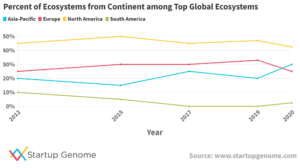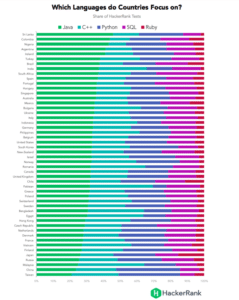How to hire remote software developers in-2020 and how much does it cost?

Remote work is only increasing – as tech teams of top companies are in no hurry to shift back from working remotely, while others hire software developers remotely to extend their existing teams or build-remote software development teams from scratch.

The global lockdown has created a new taste for remote work – with a whopping 98% believing that remote work is here to stay.
How to Hire Remote Software Developers?
Whatever your situation may be, we’ve listed plenty of useful information on hiring and setting up a successful remote development team.
So before you go for a remote team structure, you should consider the following. Ask yourself:
- Am I able to find the best software developers in my country? Or can my business benefit from a global talent pool?
- Is time to market/product development critical for success? How fast do I need to onboard Engineers and get them to speed?
- How can I reduce my operation costs? Do I require my Engineers to physically be present in the office? or am I satisfied as long they are in constant contact and meeting deliverables?
- Can I be more hand-on with my remote team and integrate them into our company culture?
If you decide to tap into a global talent pool, establish a virtual office, and build a culture that fits your company DNA— Read on. You are ready to hire remotely. This article will guide you through each step of the hiring process.
1. Choose a remote destination that works for you
Today, working remotely isn’t any different to having your development team in-house, thanks to high-quality internet and a multitude of available communication tools.
In fact, a handful of countries around the world have established themselves as popular destinations to hire a remote development team. These countries are mainly in South America, Africa, Eastern Europe and Asia.
Consider which country to choose by comparing the tech talent pools, time zone differences, and software development rates/average software developer salaries in each destination.
Tech talent pool
According to Evans Data Corporation, the number of software developers globally increased from 23 million in 2018 to 26.4 million in 2019 and is expected to grow to 27.7 million by 2023. Here’s a breakdown of developers according to regions.
| US | 4.4 Mn Software Engineers |
| Europe | 5.5 Mn Software Engineers |
| Asia – Pacific | has the biggest talent pool — 10 Mn Software Engineers |
Best startup ecosystems in the world
Startup Genome recently published The Global Startup Ecosystem Report 2020 with some interesting findings. It ranks the top ecosystems by a number of metrics including performance, funding, connectedness, talent and knowledge.

The global startup economy remains large, creating nearly $3 trillion in value. In recent years, we’ve seen the rise of Asia-Pacific region, which has gone from having 20% of top ecosystems in 2012 to 30% of them today.
“Sri Lanka’s startup ecosystem value has more than quadrupled while also ranking #1 for Affordable Talent in the Asia-Pacific region”
Software Development in Sri Lanka in 2020
Here are some facts on Sri Lanka’s rise as offshoring destination:
- The country ranks #1 for affordable talent in the Asia-Pacific region by Startup Genome.
- In the last decade alone, the Sri Lankan IT-BPM industry has expanded by 300% to reach $1.2 Billion in export revenue.
- The Island is a key talent and technology supplier for several international brands such as eBay, Paypal, Expedia, Emirates and other top tech brands.
- Currently, Sri Lanka’s IT sector employs over 80,000 skilled executives and is expected to grow over 20% year-on-year.
- And that’s not all, Sri Lankan engineers power some of the most successful startups and scale-ups from the Netherlands such as Harver, Temper, Otrium, Fixico, Pastbook to name a few.
Find more Why Dutch Tech Companies find Sri Lanka Attractive for Software Offshoring
Tech Stack
Another factor to consider is which countries have specific preferences when it comes to programming languages. HankerRank breaks down the proportion of tests taken in each language by a country which gives an overview of the preferences.

Sri Lanka comes in at number one in its preference for Java. While Taiwan has the most results in Python and Japan in Ruby.
In general, developers of different nationalities participate in Java challenges more than tests in any other programming language (with a few notable exceptions like Malaysia and Pakistan, where users prefer C++, and Taiwan, where Python is king).
Remote developer rates
In Eastern Europe, Software Development ranges from $30 to $50 per hour while in Latin America remote developers charge between $30 and $60 hourly.
The 2020 offshore hire rates in Asian countries such as Sri Lanka, China & Philippines is $25 while India and Malaysia charge $30 hourly.
Not sure if you can hire?
Try the Gapstars Savings Calculator. Using this handy tool, you can find out how much you can save on your software development team, without compromising code quality or control.
Gapstars offers tech companies an innovative remote extended team model to help you scale up in a flexible and cost-effective way.
Time zones
If you’re stationed in Europe, the time zone difference with Eastern European countries, like Ukraine, Belarus, or Hungary, is shorter — only 1 to 2 hours.
You and your remote software team can have a simultaneous workday if your time zones are close.
Yet you may have a greater advantage when you have a 4-5 hour difference with time zones in South Asia. Since you and your remote software developers have plenty of time to sort through the tasks and prepare ahead before communicating.
2. Choose the right remote working model

Depending on your business needs and requirements there are different remote software development models that you can choose from. There are mainly two remote software development models:
- Software outsourcing/offshoring – An outsourced team is the most traditional, and least hands-on option.
- Extended Teams – An extended team model allows you to integrate top engineers into your in-house team, even if they work remotely. Instead of outsourcing the entire development process – including management – you remain in charge of the development process.
To shed some light on the two main models, we’ve made a list of key areas on how extended team is different to outsourcing and why it is ideal for scale-ups.
3. Find and Hire Remote Software Developers
The success of your tech business depends on finding and hiring the right team of talented engineers. However, hiring remote software developers can be less straightforward.
The software development model you choose will ultimately determine your hiring method.
Here are tips to help you find and hire the right remote engineers based on our experience with clients:
- Go beyond just technical aspects, because you want engineers that you can work alongside. Consider the skill set required to excel at remote working.
- Ensure members of your in-house team are also part of the recruitment process.
- Use a number of screening methods including tech assessments – tech talent is hot in any market. So ensure to give fast feedback and let them know the next step.
- Visit the final candidates. Invest in some real face time at the start of your cooperation.
Learn more on why hiring remote software developers is beneficial and find our step-by-step method for hiring remote engineers.
Onboarding and Setting up your Remote Team
Now that you have selected your tech stars, it’s time to get them up to speed with the working arrangements. You’d want your remote team treated just as your in-house team.
Onboarding is all the more important for remote teams since they don’t have as many opportunities to organically integrate into the company processes and culture.
Consider the following best practices for onboarding remote employees and integrating them into your company culture:
- Face-to-Face Connections – The pandemic might not allow travel, but technology is keeping everyone connected – even much more than before.
- Set expectations with open communication – Smooth and frequent communication is essential when working with a remote team.
- Organize your collaboration – With the scope and milestones defined, the next step would be to simplify decision making.
Here at Gapstars, the agile approach has helped us to build a tight-knit and transparent team of people who share different tasks and responsibilities related to the delivery of the product.
Each development team typically undergoes 5 stages of development:
- Forming – The team is friendly and ready to start a corporation. At this stage, they are accommodative and receptive to change.
- Storming – At this stage, the team is getting to know each other’s strengths and weaknesses. Which could cause different opinions and conflicts.
- Norming – Mutual respect begins and everyone understands their role.
- Performing – At this stage, the team is motivated, confident and clear about the goals they want to achieve.
- Adjourning – Once the goals are accomplished the team is ready to be disbanded.